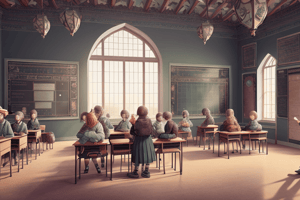Podcast
Questions and Answers
What does the author emphasize as crucial in understanding school shootings?
What does the author emphasize as crucial in understanding school shootings?
What aspect of the shootings should a reasoned approach focus on?
What aspect of the shootings should a reasoned approach focus on?
What is highlighted as a similarity among most of the shooters in various cases?
What is highlighted as a similarity among most of the shooters in various cases?
What is defined as a legitimate response to perceived humiliation according to the text?
What is defined as a legitimate response to perceived humiliation according to the text?
Signup and view all the answers
In what context were most of the shooters harassed, according to the text?
In what context were most of the shooters harassed, according to the text?
Signup and view all the answers
What does the text suggest about the shooters in relation to masculinity norms?
What does the text suggest about the shooters in relation to masculinity norms?
Signup and view all the answers
What should be focused on regarding the school shootings?
What should be focused on regarding the school shootings?
Signup and view all the answers
What distinguishes the shooters according to the text?
What distinguishes the shooters according to the text?
Signup and view all the answers
What characterizes the boys discussed in the text?
What characterizes the boys discussed in the text?
Signup and view all the answers
What aspect is deemed crucial for interpreting events leading up to school shootings?
What aspect is deemed crucial for interpreting events leading up to school shootings?
Signup and view all the answers
Study Notes
Commonality in School Shooters
- Despite differences in family background, past behavior, and parental relationships, a commonality exists among school shooters.
- This uniformity cuts across all other differences among the shooters.
Two Waves of School Shootings
- 1982-1991: Most shootings in this period were targeted, urban, and involved visible minorities with handguns.
- 1992-2002: 22 of 23 shootings were committed by White students in suburban schools, most often armed with rifles rather than handguns.
Psychological Reductionism
- As the race and class of the perpetrators shifted, so did the public perception of school violence.
- The public shifted the blame from group characteristics to individual psychological problems, assuming that White suburban boys were deviants who broke away from an otherwise genteel suburban culture.
Distribution of School Shootings
- School shootings do not occur uniformly or evenly in the United States.
- All but 1 of 28 school shootings between 1982 and 2001 were in rural or suburban schools, and all but 2 were committed by White boys.
Masculinity and School Shootings
- The common factor in all cases of random school shootings is masculinity.
- The cultural marginalization of White boys who commit school shootings extends to feelings of no other recourse, no validation of their fragile identities, and no access to other methods of self-affirmation.
- According to Erving Goffman, the hegemonic masculinity in the USA is defined by a specific set of characteristics, including being young, married, white, urban, northern, heterosexual, Protestant, a father, of college education, fully employed, of good complexion, weight, and height, and a recent record in sports.
Why Only White Boys?
- African American boys face a multitude of challenges in schools, but they do not plan and execute random mass shootings.
- White boys who are bullied are supposed to be real men, embodying independence, invulnerability, and manly stoicism.
- The cultural marginalization of these boys leads to feelings of shame, inadequacy, and vulnerability, which can be restored through violence.
Conclusion
- Researchers must understand how structural forces shape and mold young men's identities and explore the seams of resistance, where they might carve out a masculinity that is authentic, grounded, and confident.
- A reasoned approach to understanding school shootings must take gender seriously, specifically the constellation of adolescent masculinity, homophobia, and violence.
Studying That Suits You
Use AI to generate personalized quizzes and flashcards to suit your learning preferences.
Description
Test your knowledge on the common traits among school shooters, regardless of differences in family backgrounds or behavior patterns. Explore the two waves of school shootings between 1982 and 1991, focusing on gang violence, visible minorities, and urban environments.



